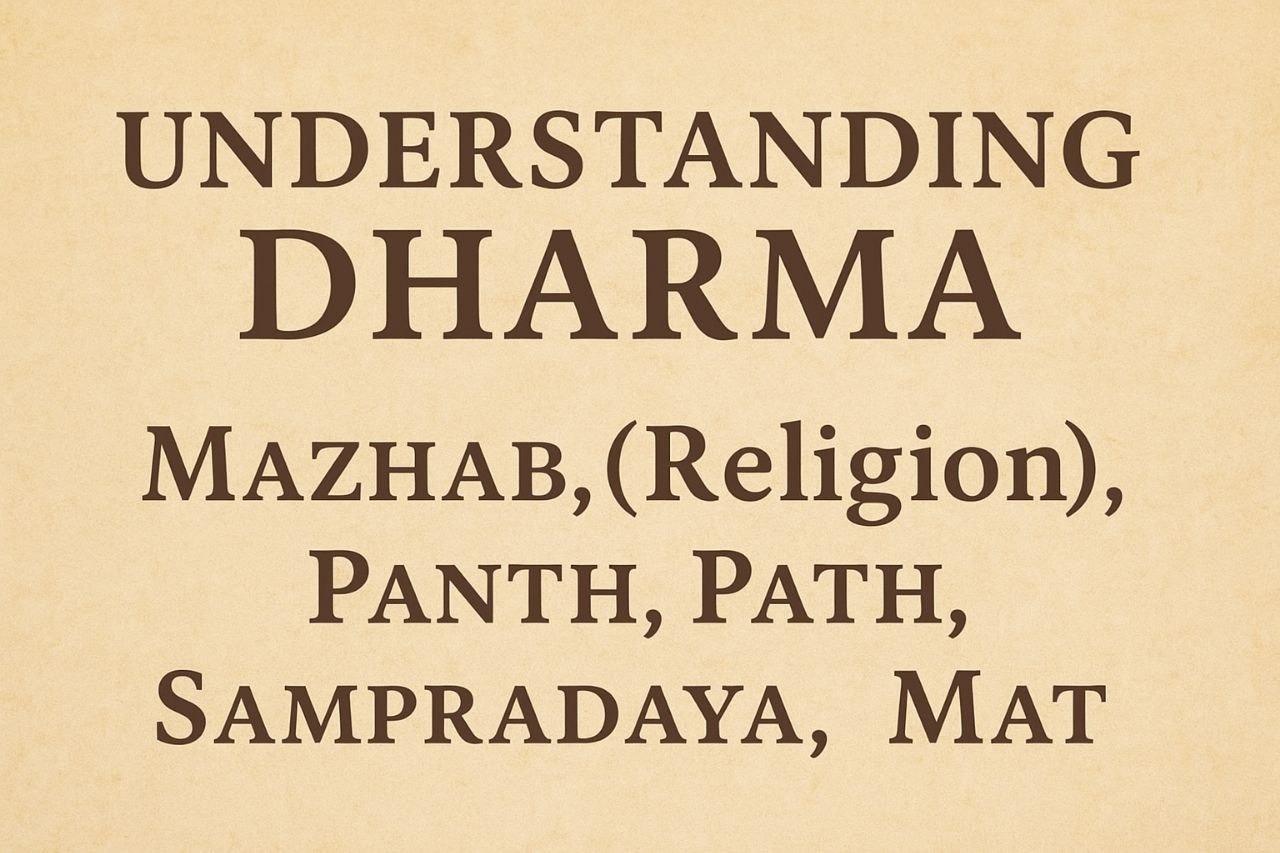Understanding Dharma, Mazhab(Religion), Panth, Path, Sampradaya, and Mat: A Journey Through Spiritual and Religious Vocabulary

In the rich cultural and spiritual landscape of India and beyond, words like Dharma, Mazhab, Panth, Path, Sampradaya, and Mat are often used, sometimes interchangeably. However, each of these terms holds a unique and profound meaning. To truly understand the diversity of human belief systems and spiritual paths, it is essential to explore the depth of these concepts.
Let’s take a detailed journey through these six deeply rooted terms.
Dharma ~ The Eternal Law of Righteousness
Origin:
Derived from the Sanskrit root “Dhṛ”, meaning to hold, sustain, or support.
Essence:
Dharma is not religion in the conventional sense; it is the cosmic principle that maintains harmony in the universe. It represents righteousness, duty, ethics, and the natural order. Dharma is dynamic, what is dharmic for one may differ for another depending on their stage in life and context.
Examples:
Sanatan Dharma ~ Eternal order, commonly referred to as Hinduism.
Buddha Dharma ~ The path taught by Gautama Buddha.
Jain Dharma ~ The path of non-violence and asceticism taught by the Tirthankaras.
Sikh Dharma ~ The path of truthful living, equality, and devotion as taught by Guru Nanak and the ten Sikh Gurus.
Mazhab(Religion) ~ Structured Religion and Doctrine
Origin:
An Arabic term, “Mazhab” literally means “a path” or “way of going.”
Essence:
Mazhab refers to organized religion with defined beliefs, rituals, and scriptures. It often includes a prophet or founder and a set of prescribed commandments or laws.
Examples:
Judaism ~ Based on the Torah and Jewish traditions.
Christianity ~ Based on the Bible and the teachings of Jesus Christ.
Islam ~ Based on the Quran and teachings of Prophet Muhammad.
Panth ~ A Devotional or Spiritual Path
Origin:
Derived from the Sanskrit word “Patha”, meaning road or route.
Essence:
Panth is a specific spiritual path or community that emerges from a saint or guru’s teachings. It exists within a broader dharmic or religious tradition but highlights distinct methods and philosophies.
Examples:
Kabir Panth ~ Based on the teachings of Sant Kabir.
Dadu Panth ~ Inspired by Saint Dadu Dayal.
Nanak Panth ~ The followers of Guru Nanak, later known as Sikhism.
Path ~ The Individual’s Spiritual Journey
Essence
While similar to “Panth,” Path in spiritual discourse refers more to an individual’s journey toward self-realization or divine union. It’s not bound by institutional structures but rather by inner pursuit and discipline.
Examples:
Bhakti Yoga - Path of devotion.
Jnana Yoga - Path of knowledge.
Karma Yoga - Path of selfless action.
Raja Yoga - Path of meditation and control of the mind.
Each path offers a way to grow spiritually based on the seeker's temperament and purpose.
Sampradaya ~ A Living Religious Tradition
Origin:
From Sanskrit, meaning a lineage or tradition passed down correctly.
Essence:
A Sampradaya is a sect or tradition within a religion, typically formed around a specific interpretation of scriptures and led by a lineage of gurus or acharyas. It maintains continuity through formal transmission of teachings.
Examples:
Sri Sampradaya ~ Initiated by Ramanujacharya, following Vishishtadvaita.
Madhva Sampradaya ~ Following Dvaita Vedanta.
Shaiva, Shakta, and Vaishnav Sampradayas ~ Focused on Shiva, Shakti, and Vishnu respectively.
Mat ~ Philosophical School or Doctrine
Origin:
Sanskrit "Mat" means opinion, belief, or viewpoint.
Essence:
Mat refers to a school of philosophical thought, often rooted in logic, scriptures, and systematic reasoning. It’s an intellectual framework used to interpret the nature of reality, the self, and the ultimate goal of life.
Examples:
Advaita Vedanta ~ Non-dualistic school founded by Adi Shankaracharya.
Dvaita Vedanta ~ Dualistic philosophy by Madhvacharya.
Vishishtadvaita ~ Qualified non-dualism by Ramanujacharya.
Charvaka Mat ~ Ancient materialist philosophy.
Why This Understanding Matters
In today’s rapidly globalizing world, where spirituality is both a personal quest and a public discourse, understanding these nuanced terms helps us appreciate the diversity of human belief systems. These concepts reflect how deeply interconnected yet uniquely expressed our inner journeys are. While Mazhab and Sampradaya might provide structure, Path and Dharma offer liberation through insight and self-discovery.
The Infinite Spectrum of Truth
Each of these terms is a lens through which truth can be seen, understood, and experienced. Whether you walk a well-trodden Mazhab, a meditative Path, a philosophical Mat, or a righteous Dharma, every step brings you closer to your own center.
"Truth is one, the paths are many. Just as rivers merge into the ocean, so do all paths merge into the Divine." ~ Adarsh Singh
Fri Apr 25, 2025
